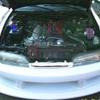N1 Oil Pump Flow More Than Factory?
Announcements
-
Similar Content
-
Latest Posts
-
If as it's stalling, the fuel pressure rises, it's saying there's less vacuum in the intake manifold. This is pretty typical of an engine that is slowing down. While typically is agree it sounds fuel related, it really sounds fuel/air mixture related. Since the whole system has been refurbished, including injectors, pump, etc, it's likely we've altered how well the system is delivering fuel. If someone before you has messed with the IACV because it needed fiddling with as the fuel system was dieing out, we need to readjust it back. Getting things back to factory spec everywhere, is what's going to help the entire system. So if it idles at 400rpm with no IACV, that needs raising. Getting factory air flow back to normal will help us get everything back in spec, and likely help chase down any other issues. Back on IACV, if the base idle (no IACV plugged in) is too far out, it's a lot harder for the ECU to control idle. The IACV duty cycle causes non linear variations in reality. When I've tuned the idle valves in the past, you need to keep it in a relatively narrow window on aftermarket ecus to stop them doing wild dances. It also means if your base idle is too low, the valve needs to open too much, and then the smallest % change ends up being a huge variation.
-
I guess one thing that might be wrong is the manifold pressure. It is a constant -5.9 and never moves even under 100% throttle and load. I would expect it to atleast go to 0 correct? It's doing this with the OEM MAP as well as the ECU vacuum sensor. When trying to tune the base map under load the crosshairs only climb vertically with RPM, but always in the -5.9 column.
-
AHHHH gotchaa, I'll do that once I am home again. I tried doing the harness with the multimeter but it seems the car needed a jump, there was no power when it was in the "ON" position. Not sure if I should use car battery jump starter or if its because the stuff that has been disconnect the car just does send power.
-
As far as I can tell I have everything properly set in the Haltech software for engine size, injector data, all sensors seem to be reporting proper numbers. If I change any injector details it doesnt run right. Changing the base map is having the biggest change in response, im not sure how people are saying it doesnt really matter. I'm guessing under normal conditions the ECU is able to self adjust and keep everything smooth. Right now my best performance is happening by lowering the base map just enough to where the ECU us doing short term cut of about 45% to reach the target Lambda of 14.7. That way when I start putting load on it still has high enough fuel map to not be so lean. After 2500 rpm I raised the base map to what would be really rich at no load, but still helps with the lean spots on load. I figure I don't have much reason to be above 2500rpm with no load. When watching other videos it seems their target is reached much faster than mine. Mine takes forever to adjust and reach the target. My next few days will be spent making sure timing is good, it was running fine before doing the ECU and DBW swap, but want to verify. I'll also probably swap in the new injectors I bought as well as a walbro 255 pump.
-
By AnimalGarage · Posted
It would be different if the sealant hadn't started to peel up with gaps in the glue about ~6cm and bigger in some areas. I would much prefer not having to do the work take them off the car . However, the filler the owner put in the roof rack mount cavities has shrunk and begun to crack on the rail delete panels. I cant trust that to hold off moisture ingress especially where I live. Not only that but I have faded paint on as well as on either side of these panels, so they would need to come off to give the roofline a proper respray. My goal is to get in there and put a healthy amount of epoxy instead of panel filler/bog and potentially skin with carbon fiber. I have 2 spare rolls from an old motorcycle fairing project from a few years back and I think it'd be a nice touch on a black stag. I've seen some threads where people replace their roof rack delete with a welded in sheet metal part. But has anyone re-worked the roof rails themselves? It seems like there is a lot of volume there to add in some threads and maybe a keyway for a quick(er) release roof rack system. Not afraid to mill something out if I have to. It would be cool to have a cross bar only setup. That way I can keep the sleek roofline that would accept a couple bolts to gain back that extra utility 3D print some snazzy covers to hide the threaded section to be thorough and keep things covered when not using the rack.
-







Recommended Posts
Create an account or sign in to comment
You need to be a member in order to leave a comment
Create an account
Sign up for a new account in our community. It's easy!
Register a new accountSign in
Already have an account? Sign in here.
Sign In Now